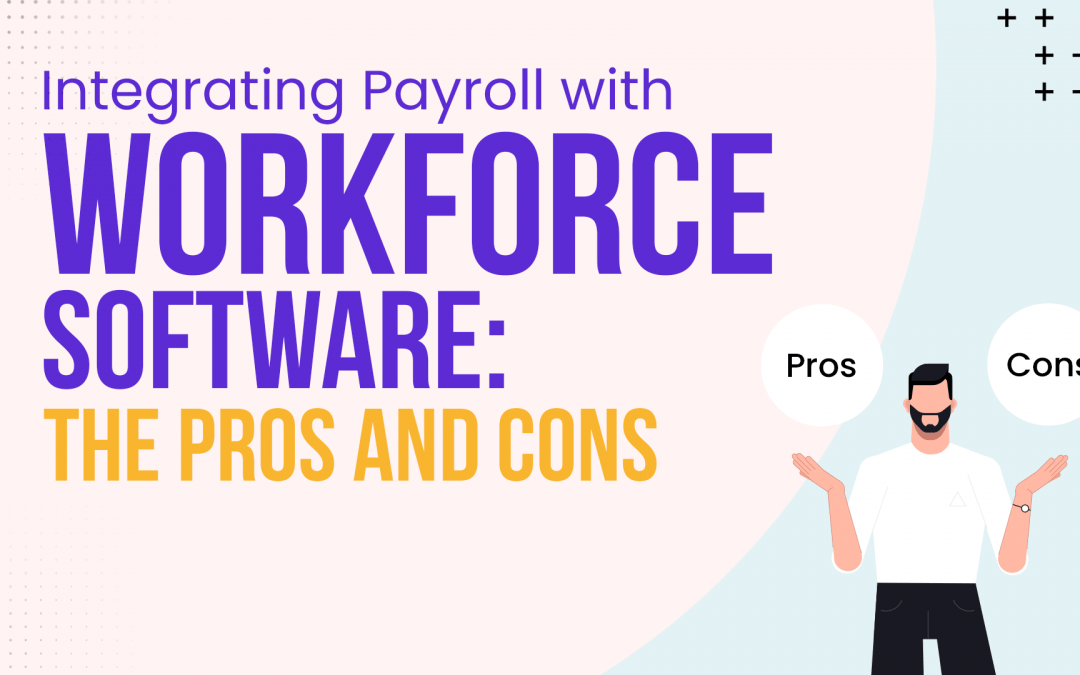Starting a business is very easy, but improving performance and satisfying clients can be challenging. Particularly, if you are using manual processes to manage your workforce and calculate payrolls, you are more likely to make mistakes and fall through the cracks.
To address these challenges, most companies now integrate their workforce software with payroll systems. This integration allows them to better handle employee payroll data and make accurate calculations with minimal risks. Moreover, having a centralized system for HR, payroll, time and attendance, and benefits administration helps companies save time and reduce their operational expenses. However, this integration also has some limitations like high initial costs, limited autonomy, and complex maintenance requirements.
In this article, we will discuss the key benefits and limitations of integrating payroll with workforce software. Let’s dive in!
What is an Integrated HR Payroll System?
Workforce management and payrolls are two key functions of an organization. Although both these functions correlate to each other, some companies use different software systems for their administration. This takes more time and sometimes results in inaccuracies that make operations less efficient.
An integrated HR payroll system combines core HR functions and payrolls into a single system. It allows companies to manage their employee records, track time and attendance, and process payroll from a unified platform. Team leads and HR managers can calculate employee working hours and estimate their weekly or monthly wages with a few clicks.
This way, integrating payroll with workforce software helps companies improve their operational efficiency and achieve their desired goals.
Pros of Integrating Payroll with Workforce Software
Given below are some of the top benefits of using integrated HR payroll software:
1. Improved HR Efficiency
The first benefit of using integrated HR payroll software is that it improves the overall efficiency of HR operations. Employees can record their clock-in and clock data or confirm their shift availability from their smartphones. Besides, they can update their personal information online, review their weekly or monthly shift performance, and access their desired data anytime, anywhere.
On the other hand, HR managers or team leads can stay updated on all activities performed by their employees through an integrated system. Besides, they can get real-time insights into sign-in and sign-out, calculate employee hours, and make informed decisions for better results.
2. Time-Saving
Bringing core HR functions and payrolls into a single interface not only streamlines HR operations but also helps companies save time. Instead of switching between different systems to schedule shifts, track time, calculate wages or process payrolls, HR managers can perform all these functions from a centralized dashboard.
Hence, integrated workforce software reduces manual workload and eliminates the need for purchasing multiple solutions to perform different functions. Besides, companies need a smaller number of workers to perform core HR functions by automating traditional processes.
3. Enhanced Accuracy and Security
Remember the times when managers would use paper logbooks to manage employees’ attendance records and calculate wages? These traditional methods were not only time-consuming but also prone to physical damage or human errors. Hence, both data accuracy and security could be compromised with these methods.
However, integrated HR payroll software improves data accuracy by enabling staff members to reduce and update their profiles and fix inaccuracies on time. The system updates employee time and payroll data in real-time and eliminates the risk of human errors. This way, companies can effectively handle employee records and make accurate payroll calculations without compromising data security.
Cons of Integrating Payroll with Workforce Software
Here are some of the disadvantages of integrated HR payroll software:
1. High Initial Costs
Implementing an integrated HR payroll system across your organization requires high initial costs. Particularly, if you have a large workforce size, you may require more time to build on ROI and bear upfront and setup fees. This makes it very difficult for startups with limited resources to use integrated HR payroll software.
Moreover, the implementation of fully automated and integrated HR payroll software may take a lot of months in data migration, software testing, and configuration. Hence, there may arise different compatibility and integration problems that may create problems in HR operations. You may also need to hire an IT expert to solve technical problems that will increase your operational expenses.
2. Complexity and Maintenance
Another key challenge with integrated payroll and workforce software is that need more specialized maintenance due to their complexity. To effectively implement these systems in your organization, you have to provide your employees with basic training on how to use these systems for better results.
Hence, a steeper learning curve can elongate the time required for complete adoption. These unnecessary time delays might disrupt your HR operations and reduce overall organizational performance.
3. Cybersecurity Issues
The biggest challenge with cloud-based integrated systems is that they are connected to the internet and often suffer from cybersecurity issues. When you set up your company profile on cloud-based software, your confidential information can be at risk of theft by cybersecurity experts.
Unless your integrated solution has taken appropriate steps to counter cybersecurity threats, any unauthorized user can steal your confidential data. This may result in financial or reputational losses and a decline in your team’s productivity.
Final Words
Businesses need integrated systems to effectively handle their HR operations and process payrolls. These systems make it easy for managers to save time, review staff performance, and bring accuracy to payroll calculations.
Besides, integrating payroll with workforce software enables companies to improve the efficiency of their HR operations, reduce their operational costs, and save time.
On the other hand, implementing integrated software required high initial setup costs and time. The complexity of maintenance and operations can decline in overall organizational performance. Hence, a well-planned implementation strategy is necessary to effectively use an integrated HR payroll system for better results.
